Will radiant heating become competitive?
One of the most progressive ways to heat a house is radiant heating. It confirms with someone what has been said - “everything is new, it is well forgotten old”. If you compare the method with gas heating or steam, it has much more advantages, including the cost of it is much less.
It is possible to save at the expense of a slightly different return of combustible fuel, which is transformed into a reduction in the cost of operating the space heating system.
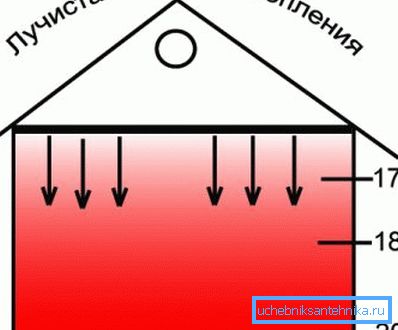
Stereotype thinking
As with everything “new,” customers have not yet developed an interest in this type of heating, although they also understand the full benefits of this method, which they have repeatedly said. However, the choice in most cases falls on the traditional methods of heating, although for large rooms it is not always suitable and does not justify the costs.
Why did such a stereotype arise?
We can distinguish two of its components:
- the instruction required to use in Soviet times to heat large areas of the system connected to the central boiler house;
- ignorance of the physical principle of the radiant method of heating.
It should also be said that the development of the project in this case will be more difficult, in contrast to traditional methods. Here it is necessary to take into account many conditions that will directly affect the thermal comfort of a person in the zone of radiant heating.
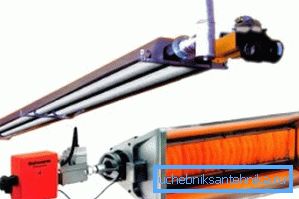
A bit of history
In the 19th century, home heating systems began to change. Gradually, fireplaces and steel stoves will be replaced by water heating, which produces convective heat. The radiant heating system was forgotten, but, thanks to research by scientists who have conducted research in this area over the past half century, it has returned. Such heat can surpass its convective characteristics in a number of parameters.
If we recall the story even deeper, the only source of heat in those days was a fire, heating of dwellings - by convection-beam. Infrared rays spread from the room, and due to convection, the air heated the room.
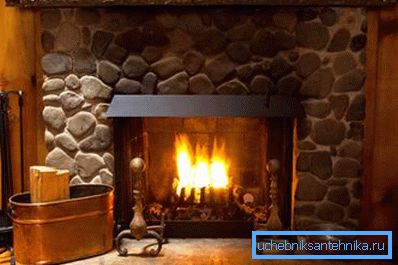
The disadvantage of this method was the smoke, because of which the air became unbearable, because the primitive chimney in the form of a hole did not contribute to the effective removal of smoke. The main focus was on radial heating, because its intensity was in no way dependent on air heating.
Then mankind has improved heating systems, using hot smoke for heating, passing it through the channels. Developed air-heating circuits, until she found a method of heating rooms with hot water.
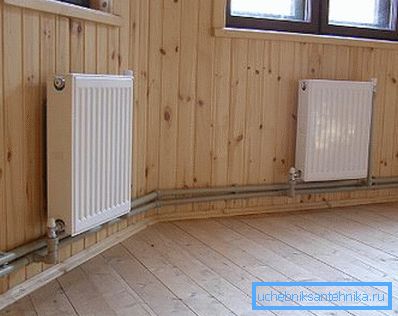
But the circle nevertheless closed when the scientists proved that the perception of radiation heating is much closer to us than convection heating of the air. This applies not only to the person, but also to household items and materials used in the interior decoration of rooms.
We will understand more
From school physics lessons, we know that heat is one of the ways in which energy is manifested, which can spread in space in three main ways.
Among them:
- Convection - the spread of air.
- Conduction - conductivity.
- Electromagnetic waves - radiation.
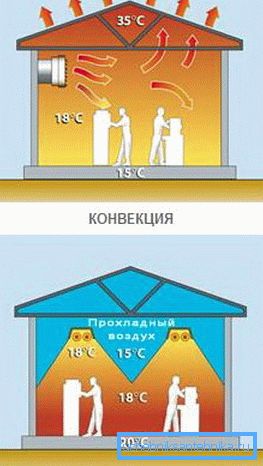
| Convection and conduction |
|
| Radiation |
|

- In the latter case, radiant heaters are installed at a certain height above the floor.
- When turned on, electromagnetic waves begin to radiate.
- Passing with minor losses through the air, they are absorbed by the floor and objects, increasing their temperature.
- The temperature in the room increases.
You can compare the effect of radiant heating with a walk on a sunny day in spring. At this moment the air is still not sufficiently heated, but the rays are already beginning to warm the earth, because of which we feel pleasant warmth.
Tip: the best coefficient of heat energy between air temperature and objects can be achieved only in houses with high-quality thermal insulation.

Types of radiant heating
An ideal source of radiant heating is a massive stove, but in the conditions of a city office or apartment, as well as in many houses, it is not possible to make it.
Below we will consider the modern versions of this type of heating of the building, which will allow to do without it:
- "warm floor";
- wall and ceiling panels.
| Warm floor | This option of heating may differ in design and principle of heating:
|
| Wall panels |
The advantage of the equipment is low thermal inertia, in contrast to the “warm floor”, it is especially convenient for buildings where there is a periodic heating mode. For efficient heating, it is necessary to leave free space around the perimeter. |
| Ceiling panels |
|
Tip: it is not recommended to use wall panels, if a large number of cabinet furniture is used next to them.
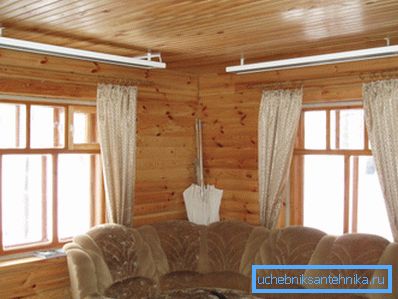
Heating in the home
A simple example is if a sufficient number of people are gathered in an unheated room, after a while it will become much warmer. How did this happen?
Of course, not because everyone “breathed”. This is due to the thermal radiation of our body.

Gradually, infrared rays heat objects near them, and then they generate their radiation, resulting in a warmer temperature. And it turns out that no hot water radiators are needed.
The intensity of the process depends on the temperature of the object, which is able to generate infrared rays. Consumption of the latter does not depend on the ambient air temperature, but on the temperature of objects and enclosing structures (floor, walls and ceiling).
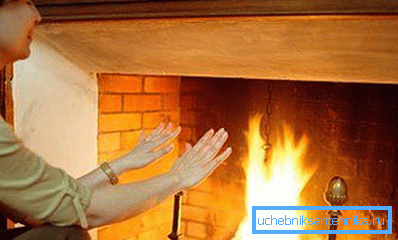
Usually we are used to compensating for them with the help of convection heating, using convectors of different types. For example, you can often hear that in a wooden house the “breathing” of walls allows you to compensate for the humidity of the air, in fact, the main role in this is played by an ordinary brick kiln.
Because of the massive construction, she was given a significant place in a room in which she perfectly kept warm and heated it with infrared radiation. Neither air nor water system can argue with such heating.
Conclusion
Today was told about the heating of the room with the help of radiant energy. Gradually, consumers are beginning to understand its superiority over conventional convection heating of housing, but the stereotype of thinking still prevails. Of course, in the apartment of a multi-storey building you cannot install a fireplace on wood or a stove, but the industry offers enough types of electrical appliances capable of generating radiant heating.
Thanks to him, you can get the "sunshine" even on the most overcast day. Video in the article will provide an opportunity to find additional information on the above topic.